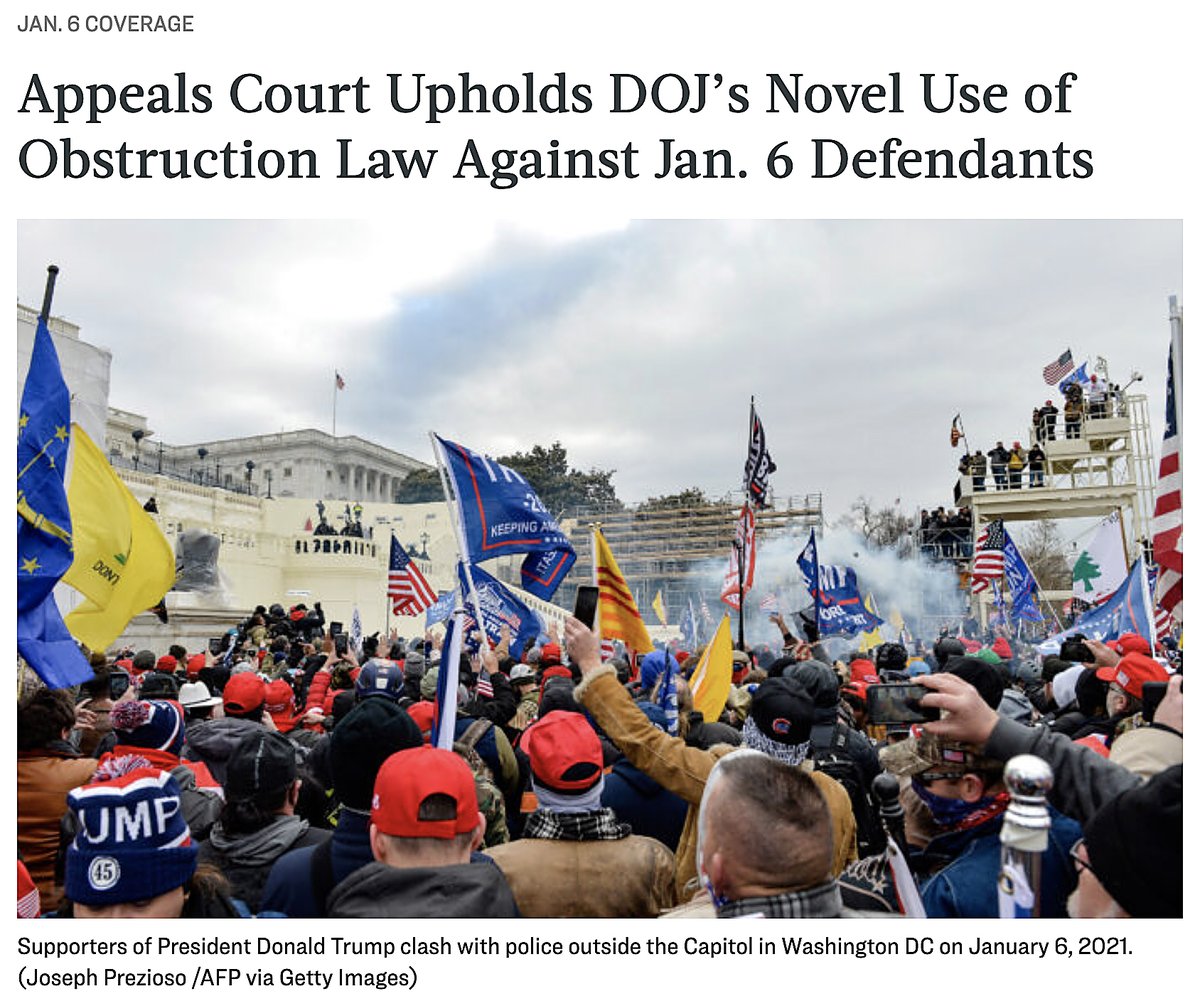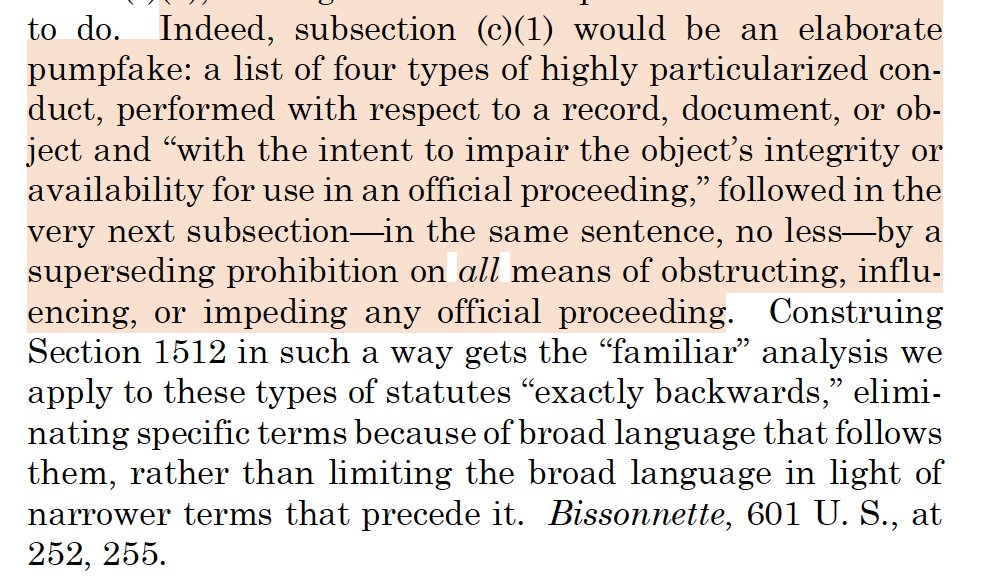The Supreme Court ruling in the #Jan6 case Fischer v. United States has generated huge interest and speculation on what happens next. Here is a thread with background on the case and quotes from the June 28 6-3 majority opinion. 🧵 

355 defendants were charged with violating 18 U.S. Code §1512(c)(2) for allegedly “obstructing” the counting of Electoral College votes from the 2020 presidential election by a joint session of Congress on #Jan6, 2021. 🧵
Obstruction of Congress under §1512(c)(2) is the most widely charged felony among #Jan6 cases. The charge carries a maximum prison term of 20 years. 🧵
Joseph Wayne Fischer of Jonestown, Pennsylvania was one of those charged with violating §1512(c)(2). On Dec. 13, 2023, the U.S. Supreme Court granted certiorari to Fischer’s petition of appeal. 🧵 

The case involves use of 18 U.S. Code Section 1512, which provides: (c) Whoever corruptly—
(1) alters, destroys, mutilates, or conceals a record, document, or other object, or attempts to do so, with the intent to impair the object’s integrity or availability for use in an official proceeding; or
(2) otherwise obstructs, influences, or impedes any official proceeding, or attempts to do so, shall be fined . . . or imprisoned not more than 20 years, or both. 🧵
(1) alters, destroys, mutilates, or conceals a record, document, or other object, or attempts to do so, with the intent to impair the object’s integrity or availability for use in an official proceeding; or
(2) otherwise obstructs, influences, or impedes any official proceeding, or attempts to do so, shall be fined . . . or imprisoned not more than 20 years, or both. 🧵
The statute was part of the mammoth 2002 Sarbanes-Oxley Act, which aimed to combat corporate fraud and increase accountability in the financial disclosures of publicly traded companies. The legislation was co-authored by Sen. Paul Sarbanes (D-Md.) and Rep. Michael Oxley (R-Ohio). 🧵
The provisions of Section 1512(c) used against the Jan. 6 defendants are contained in a section of the Sarbanes-Oxley Act titled the “Corporate Fraud Accountability Act of 2002.” 🧵 

U.S. District Judge Carl Nichols threw out the obstruction charge filed against Fischer and defendants Edward Jacob Lang of New York, and Garret A. Miller of Texas. Miller and Lang filed similar petitions of appeal with the Supreme Court, but the justices agreed to take up only the Fischer case. 🧵

In a March 2022 memorandum opinion, Judge Nichols said the charge against Miller “requires that the defendant have taken some action with respect to a document, record, or other object in order to corruptly obstruct, impede or influence an official proceeding." 🧵
A three-judge panel of the U.S. Court of Appeals for the District of Columbia Circuit muddied the waters in April 2023 with a fractured 1–1–1 decision. Only a partial concurrence by one of the judges appeared to reverse Judge Nichols and uphold the DOJ’s broad interpretation of the law. 🧵

Issued June 28, 2024, the Supreme Court Fischer ruling rejects the DOJ’s interpretation—ratified by Court of Appeals Judge Flo Pan—that subsection (c)(2) is a “catch-all” provision in which the word “otherwise” covers “all forms of corrupt obstruction of an official proceeding other than the conduct that is already covered by §1512(c)(1)." 🧵

Judge Pan “held that the word ‘otherwise’ in Section 1512(c)(2) means that the provision unambiguously covers ‘all forms of corrupt obstruction of an official proceeding, other than the conduct that is already covered by §1512(c)(1),’” the SCOTUS ruling said. 🧵
The 6-3 Supreme Court opinion would appear to rule out use of 1512(c)(2) to punish Jan. 6 protesters for simply causing a delay in counting of Electoral College votes. At a minimum, though, it requires prosecutors to show defendants somehow impaired evidence related to the official proceeding. 🧵
The SCOTUS majority said the government “must establish that the defendant impaired the availability or integrity for use in an official proceeding of records, documents, objects, or as we earlier explained, other things used in the proceeding, or attempted to do so." 🧵
"If Congress had wanted to authorize such penalties for any conduct that delays or influences a proceeding in any way, it would have said so,” the opinion reads. “Instead, Section 1512 mentions ‘record,’ ‘document,’ or other ‘object’ 26 times." 🧵
"Our usual approach in obstruction cases has been to ‘resist reading’ particular sub-provisions ‘to create a coverall’ statute, as the Government would have us do here,” the opinion said. 🧵
The sweeping “other obstruction” interpretation of (c)(2) by the DOJ is a “novel interpretation” that would “criminalize a broad swath of prosaic conduct, exposing activists and lobbyists alike to decades in prison,” the decision stated. 🧵
"Such a reading of subsection (c)(2) would lump together disparate types of conduct for which Congress had assigned proportionate penalties” in subsections (a)(2) and (d)(1), the ruling said. 🧵
"If the Government were correct, then the ‘otherwise obstructs, influences, or impedes any official proceeding’ provision—which is buried in subsection (c)(2) of Section 1512—would largely obviate the need for that broad array of other obstruction statutes," the opinion stated.🧵
“The better conclusion is that subsection (c)(2) was designed by Congress to capture other forms of evidence and other means of impairing its integrity or availability beyond those Congress specified in (c)(1).” 🧵
The High Court majority concluded, “…our narrower interpretation of subsection (c)(2) is the superior one." 🧵
“Indeed, subsection (c)(1) would be an elaborate pumpfake: a list of four types of highly particularized conduct, performed with respect to a record, document, or object and ‘with the intent to impair the object’s integrity or availability for use in an official proceeding,’ followed in the very next subsection—in the same sentence, no less—by a superseding prohibition on all means of obstructing, influencing, or impeding any official proceeding." 🧵

The High Court vacated the Court of Appeals ruling that endorsed the broad interpretation of 1512(c)(2) and remanded the case “for further proceedings consistent with this opinion.” 🧵
In the mean time, the U.S. District Court in Washington D.C. will begin dealing with pending motions from defendants and an expected flurry of new motions to vacate the obstruction charge. /end 🧵 

• • •
Missing some Tweet in this thread? You can try to
force a refresh





